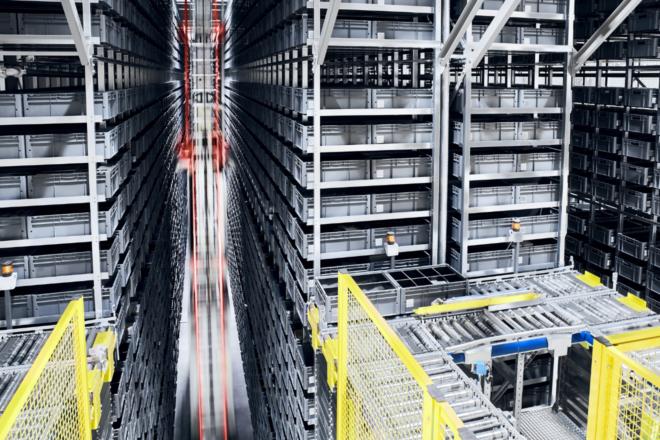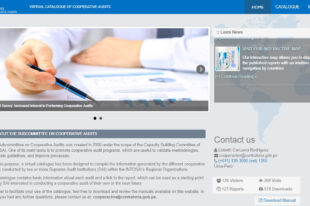Implementing Recommendations and Audit Follow up: Modernising Government Warehouses in the Kingdom of Saudi Arabia

Authors: Abdulaziz S. Alarifi and Meshari A. Almunyif, General Court of Audit, SAI of the Kingdom of Saudi Arabia
Introduction
In this era that witnesses rapid developments in technology fields and growing administrative challenges, there is an increasing need to modernise auditing systems to enhance transparency and efficiency in the management of public resources. For decades, the Kingdom of Saudi Arabia relied on a regulation of government warehouses that was adopted in 1983, which was, at the time, appropriate and effective according to the standards and requirements. This regulation, which was implemented under the supervision of the Ministry of Finance (MOF), provided a solid foundation for managing resources efficiently and effectively. In this context, the Supreme Audit Institution of the Kingdom (the General Court of Audit (GCA)) played a pivotal role in pioneering digital transformation and modernising systems through active participation in restructuring and developing the regulations of government warehouses. The last of these regulations was issued in 2020, which came into effect following its communication with the government authorities, most notably the MOF on one hand, and higher authorities on the other. This process included introducing advanced automated systems, improving government procedures, and activating administrative governance in accordance with best practices, which contributed to significantly improving government operations and services.
This article aims to demonstrate how to effectively support the implementation of audit recommendations and follow up on its implementation. This approach is a prominent example of the importance of innovation, governance, and adoption of best practices in modernising national auditing systems. In the past, warehouse management faced major challenges resulting from a lack of effective regulations and procedures, which negatively affected the efficiency and effectiveness of warehousing operations, as the main challenges were represented in two basic aspects:
- Regulation aspect: The regulations followed since the 1980s were considered outdated and did not keep pace with modern administrative and financial developments.
- Work aspect: There were no clear and organised practical procedures in the old warehouse management methods, and controls were not properly activated, which led to poor utilisation of resources.
Adopted Recommendations:
From these challenges, the GCA identified several recommendations, which were implemented, to improve government warehouse management in the Kingdom of Saudi Arabia.
Automated systems for warehouse management: Previously, warehouse management relied on paper-based procedures that met the basic needs for storage and follow up. However, these procedures, despite their effectiveness at the time, began to show shortcomings with the advancement of technology and the increase in control and monitoring requirements, which led to complications that paper-based systems were no longer effective.
A new automated warehouse management system was required to meet modern warehouse management procedures. This update was also accompanied by the addition of requirements for coding warehouse items by QR code, as this is one of the most important means of improving oversight and control over the movement of items and facilitating procedures. GCA also recommend government warehouses adopt the “first in, first out” method in warehouse management procedures.
Transfers Portal: A new page created on the government entity’s online portal, where slow-moving and returned items from the entity’s warehouses are displayed to enable other government entities to benefit from them, or to sell them.
Warehouse forms: Warehouse management forms are developed and fully automated so that warehouse items are recorded and tracked in order to increase the ability to oversee them and reduce financial waste.
Automation of inventory count form and procedures: Automation of inventory count procedures in all its forms, whether it is full or partial, periodic or continuous, is both cost effective and efficient. Governance procedures are activated in inventory count processes and linked to automated systems.
This automation has contributed to accelerating inventory counts and made it easy to calculate by QR codes, especially since the inventory count forms are also automated. This makes electronic authentication of the forms easier to share copies of inventory count forms, count committee minutes, and send final reports to GCA automatically.
All of the aforementioned development and automation of government warehouses were accompanied by GCA’s investment in developing an integrated audit system that ensures maximum benefit from its big-data. This system is integrated with the warehouse systems of government entities and is able to interpret all warehouse forms, analyse them, and issue detailed reports that assists in the performance of audits and in developing the most appropriate recommendations to government entities regarding government warehouses.
Modernising the organisational structure of warehouse units: As administrative and technological requirements changed, the need for a more flexible and efficient organisational structure emerged. The warehouse units were organisationally restructured to be linked to their respective government administrations, divisions, and/or departments, and are now organised based on the workload and requirements of each government entity. This structural transformation aims to keep pace with rapid developments and enhances administrative efficiency, as the administrative dependency of warehouse unit is determined based on the nature of the tasks, specialisation, and administrative formation of each entity. This change allows tasks to be distributed more effectively, enhancing rapid response to operational requirements, and reducing bureaucracy. The functional link between warehouses and other departments, such as procurement and finance, enhances integration and coordination between different activities, which facilitates the exchange of information and improves resource management.
Updating the responsibilities of warehouse employees: The responsibilities of government warehouse employees and certain titles have been revised. For instance, there was no longer a need for an “Item Card Clerk” position. As appropriate to meet the needs of the technological changes, these jobs or roles have been automated, and efforts and focus were diverted to other areas of government warehouse management and operations oversight, contributing to the development of employees, in terms of speed and accuracy of work.
General provisions: Due to the GCA’s accumulated experience in applying best practices in oversight, some general and important provisions have been added, which are, but not limited to:
- Establishing requirements for automated systems for government warehouses to accommodate and manage all types of warehouses, and classifying them according to type and location, governance and division of authorities in automated systems (such as: “Maker” and “Checker” control); not accepting amendments to memorandums and minutes after their approval; immediate recording and reconciliation of receipt and disbursement operations; ability to extract all types of reports, and; other requirements that ensure maximum benefits from automated warehouse systems.
- Adding space and safety requirements to warehouse units, such as optimal use of floors and spaces, availability of handling equipment and ease of movement, equipping warehouses with fire, security and safety systems, and other important requirements.
- Separating the offices of administration and supply staff from the warehouses, except for the office of the warehouse keeper or custody officer, which would be located adjacent to the receiving and disbursing areas. These general provisions ensure maximum benefit from warehouses and optimal investment of public money and efforts.
GCA’s role goes beyond the financial aspects to also include verifying several critical non-financial aspects that affect the overall performance of warehouses, including:
- Warehouse locations: Analysing whether locations are suitable for the expected functions, which contributes to improving logistics efficiency.
- Commitment to the application of all requirements: Ensuring that all entities adhere to established standards and approved automation systems, ensuring effectiveness and continuous development.
- Warehouse suitability: Evaluating the suitability of warehouses to storage and operational needs, to ensure maximum effectiveness.
- Competency of the accountable human element: Verifying the level of performance of employees responsible for warehouse management and evaluating their effectiveness and qualification to carry out their tasks.
Through these efforts, GCA works to enhance oversight and transparency, and improve the overall performance of warehouse units. This comprehensive role highlights the importance of the SAI, not only as a supervisory body, but also as a fundamental pillar in supporting and improving government operations.
Integral to the success of proposed recommendations is careful follow up to ensure their effective implementation. In this context, GCA plays an active role in reviewing the recommendation implementation through direct cooperation with the relevant government entities. Follow up includes site visits carried out by GCA professionals to verify the implementation of the regulations and procedures on the ground. In addition, the necessary documents and evidence are collected to evaluate the extent of progress that has been achieved. Periodic reports are submitted to higher authorities to ensure that the expected results achieve the desired goals and identify any obstacles that may affect the required effectiveness.
Conclusion:
Government warehouses in the Kingdom of Saudi Arabia have witnessed fundamental transformations thanks to modern regulations and the introduction of audit and governance roles. Government entities were able to enhance the efficiency of operations and achieve high levels of transparency and effectiveness. Continuous monitoring and extensive assessments have contributed significantly to improving the overall performance of warehouses. This transformation not only enhanced operational efficiency, but also raised the level of resource utilisation, which demonstrates the importance of the role SAIs play in providing recommendations that add value to government entities.






